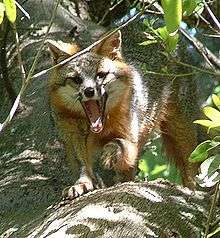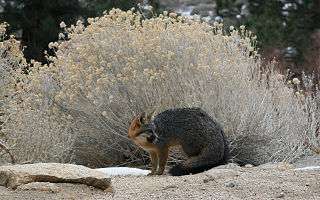Gray fox
| Gray fox | |
|---|---|
 | |
| Scientific classification | |
| Kingdom: | Animalia |
| Phylum: | Chordata |
| Class: | Mammalia |
| Order: | Carnivora |
| Family: | Canidae |
| Subfamily: | Caninae |
| Genus: | Urocyon |
| Species: | U. cinereoargenteus |
| Binomial name | |
| Urocyon cinereoargenteus (Schreber, 1775) | |
| | |
| Gray fox range | |
The gray fox (Urocyon cinereoargenteus), or grey fox, is a carnivorous mammal of the family Canidae ranging throughout most of the southern half of North America from southern Canada to the northern part of South America (Venezuela and Colombia).[2] No other canid's natural range spans both North and South America and it is the only American canid that can climb trees.[3] This species and its only congener, the diminutive Channel Island fox (Urocyon littoralis), are the only living members of the genus Urocyon, which is considered to be the most basal of the living canids.[4] Though it was once the most common fox in the eastern United States, and still is found there,[5][6] human advancement and deforestation allowed the red fox to become more dominant. The Pacific States still have the gray fox as a dominant. Its specific epithet cinereoargenteus means "ashen silver".
Origin and genetics
The gray fox appeared in North America during the mid-Pliocene epoch 3.6 million years ago (AEO) with the first fossil evidence found at the lower 111 Ranch site, Graham County, Arizona with contemporary mammals like the giant sloth, the elephant-like Cuvieronius, the large-headed llama, and the early small horses of Nannippus and Equus.[7] Genetic analyses of the fox-like canids confirmed that the gray fox is a distinct genus from the red foxes (Vulpes spp.). Genetically, the gray fox often clusters with two other ancient lineages, the east Asian raccoon dog (Nyctereutes procyonoides) and the African bat-eared fox (Otocyon megalotis).[8] Chromosome number is 2n=66.[9] Faunal remains at two northern California cave sites confirm the presence of the gray fox during the late Pleistocene.[10] Genetic analysis has shown that the gray fox migrated into the northeastern United States post-Pleistocene in association with the Medieval Climate Anomaly warming trend.[11] Recent mitochondrial genetic studies suggests divergence of North American eastern and western gray foxes in the Irvingtonian mid-Pleistocene into separate sister taxa.[12]
The gray fox's dwarf relative, the Channel Island fox, is likely descended from mainland gray foxes.[13] These foxes apparently were transported by humans to the islands and from island to island, and are descended from a minimum of 3–4 matrilineal founders.[12]
Description and behavior


The gray fox is mainly distinguished from most other canids by its grizzled upper parts, black-tipped tail and strong neck, while the skull can be easily distinguished from all other North American canids by its widely separated temporal ridges that form a U-shape. There is little sexual dimorphism, save for the females being slightly smaller than males. The gray fox ranges from 76 to 112.5 cm (29.9 to 44.3 in) in total length. The tail measures 27.5 to 44.3 cm (10.8 to 17.4 in) of that length and its hind feet measure 100 to 150 mm (3.9 to 5.9 in). The gray fox typically weighs 3.6 to 7 kg (7.9 to 15.4 lb), though exceptionally can weigh as much as 9 kg (20 lb).[14][15][16] It is readily differentiated from the red fox by the lack of "black stockings" that stand out on the latter and the stripe of black hair that runs along the middle of the tail. In contrast to all Vulpes and related (Arctic and fennec) foxes, the gray fox has oval (instead of slit-like) pupils.[17]
The gray fox's ability to climb trees is shared only with the Asian raccoon dog among canids. Its strong, hooked claws allow it to scramble up trees to escape many predators, such as the domestic dog or the coyote,[18] or to reach tree-bound or arboreal food sources. It can climb branchless, vertical trunks to heights of 18 meters and jump from branch to branch.[19] It descends primarily by jumping from branch to branch, or by descending slowly backwards as a domestic cat would do. The gray fox is nocturnal or crepuscular and makes its den in hollow trees, stumps or appropriated burrows during the day. Such gray fox tree dens may be located 30 ft above the ground.[17] Prior to European colonization of North America, the red fox was found primarily in boreal forest and the gray fox in deciduous forest, but now the red fox is dominant in most of the eastern United States since they are the more adaptable species to development and urbanization.[20] In areas where both red and gray foxes exist, the gray fox is dominant.[21]
Reproduction

The gray fox is monogamous. The breeding season of the gray fox varies geographically; in Michigan, the gray fox mates in early March, in Alabama, breeding peaks occur in February. The gestation period lasts approximately 53 days. Litter size ranges from 1 to 7. Kits begin to hunt with their parents at the age of 3 months. By the time that they are four months old, the kits will have developed their permanent dentition and can now easily forage on their own. The family group remains together until the autumn, when the young reach sexual maturity, then they disperse.
Diet


The gray fox is an omnivorous, solitary hunter. It frequently preys on the eastern cottontail (Sylvilagus floridanus) in the eastern U.S., though it will readily catch voles, shrews, and birds. In California, the gray fox primarily eats rodents, followed by lagomorphs, e.g. jackrabbit, brush rabbit, etc.[18] In some parts of the Western United States (such as in the Zion National Park in Utah), the gray fox is primarily insectivorous and herbivorous.[21] Fruit is an important component of the diet of the gray fox and they seek whatever fruits are readily available, generally eating more vegetable matter than does the red fox (Vulpes vulpes).[14]
Subspecies

There are 16 subspecies recognized for the gray fox.[9]
- Urocyon cinereoargenteus borealis (New England)
- Urocyon cinereoargenteus californicus (southern California)
- Urocyon cinereoargenteus cinereoargenteus (eastern United States)
- Urocyon cinereoargenteus costaricensis (Costa Rica)
- Urocyon cinereoargenteus floridanus (Gulf states)
- Urocyon cinereoargenteus fraterculus (Yucatán)
- Urocyon cinereoargenteus furvus (Panama)
- Urocyon cinereoargenteus guatemalae (southernmost Mexico south to Nicaragua)
- Urocyon cinereoargenteus madrensis (southern Sonora, south-west Chihuahua, and north-west Durango)
- Urocyon cinereoargenteus nigrirostris (south-west Mexico)
- Urocyon cinereoargenteus ocythous (Central Plains states)
- Urocyon cinereoargenteus orinomus (southern Mexico, Isthmus of Tehuantepec)
- Urocyon cinereoargenteus peninsularis (Baja California)
- Urocyon cinereoargenteus scottii (south-western United States and northern Mexico)
- Urocyon cinereoargenteus townsendi (northern California and Oregon)
- Urocyon cinereoargenteus venezuelae (Colombia and Venezuela)
Parasites
Parasites of gray fox include trematode Metorchis conjunctus.[22]
See also
- Urocyon progressus, also known as the progressive gray fox.
References
- ↑ Cypher; et al. (2008). "Urocyon cinereoargenteus". IUCN Red List of Threatened Species. Version 2008. International Union for Conservation of Nature. Retrieved 6 May 2008.
- ↑ Wozencraft, W.C. (2005). "Order Carnivora". In Wilson, D.E.; Reeder, D.M. Mammal Species of the World: A Taxonomic and Geographic Reference (3rd ed.). Johns Hopkins University Press. p. 582. ISBN 978-0-8018-8221-0. OCLC 62265494.
- ↑ Kurten B, Anderson E (1980). Pleistocene mammals of North America. New York: Columbia University. ISBN 978-0231037334.
- ↑ Wayne, R. K.; Geffen, E; Girman, D. J.; Koepfli, K. P.; Lau, L. M.; Marshall, C. R. (1997). "Molecular Systematics of the Canidae". Systematic Biology. 46 (4): 622–653. doi:10.1093/sysbio/46.4.622. PMID 11975336.
- ↑ Poole, E. Ann. "Gray Fox". Hikenewengland.com. Retrieved on 2011-09-15.
- ↑ "Gray fox are widespread in Connecticut.". Wildlifeofct.com. Retrieved on 2011-09-15.
- ↑ Paleobiology database, Collection 19656, Graham County, Arizona. Authority by the Dr. John Alroy, 18 February 1993.
- ↑ Geffen, E.; Mercure, A.; Girman, D. J.; MacDonald, D. W.; Wayne, R. K. (Sep 1992). "Phylogenetic relationships of the fox-like canids: mitochondrial DNA restriction fragment, site and cytochrome b sequence analyses". Journal of Zoology, London. 228: 27–39. doi:10.1111/j.1469-7998.1992.tb04430.x.
- 1 2 Fritzell, Erik K.; Haroldson, Kurt J. (1982). "Urocyon cinereoargenteus" (PDF). Mammalian Species. 189: 1–8. doi:10.2307/3503957. Retrieved 2011-11-27.
- ↑ Graham RW; Lundelius Jr. EL. FAUNMAP II: New data for North America with a temporal extension for the Blancan, Irvingtonian and early Rancholabrean. (Report). FAUNMAP II Database, version 1.0; 2010. Retrieved December 13, 2015.
- ↑ Bozarth, Christine A.; Lance, Stacey L.; Civitello, David J.; Glenn, Julie L.; Maldonado, Jesus E. (2011). "Phylogeography of the gray fox (Urocyon cinereoargenteus) in the eastern United States" (PDF). Journal of Mammalogy. 92 (2): 283–294. doi:10.1644/10-MAMM-A-141.1. Retrieved 2011-11-27.
- 1 2 Natalie S. Goddard; Mark J. Statham; Benjamin N. Sacks (August 19, 2015). "Mitochondrial Analysis of the Most Basal Canid Reveals Deep Divergence between Eastern and Western North American Gray Foxes (Urocyon spp.) and Ancient Roots in Pleistocene California". PLOS ONE. Retrieved 2015-12-13.
- ↑ Fuller, T.K.; Cypher, B. L. (2004). C. Sillero-Zubiri; M. Hoffman; D. W. Macdonald, eds. Gray fox Urocyon cinereoargenteus. pp. 92–97 in Canids: foxes, wolves, jackals, and dogs. Status survey and conservation action plan (PDF). Cambridge, United Kingdom: IUCN Publications. Retrieved 2011-11-27.
- 1 2 "Urocyon cinereoargenteus". Animal Diversity Web. Retrieved 2007-08-19.
- ↑ Boitani, Luigi (1984) Simon & Schuster's Guide to Mammals. Simon & Schuster/Touchstone Books, ISBN 978-0-671-42805-1
- ↑ Common Gray Fox (Urocyon cinereoargenteus). Nsrl.ttu.edu. Retrieved on 2013-01-26.
- 1 2 Alderton, p. 122.
- 1 2 Fedriani, J. M.; Fuller, T. K.; Sauvajot, R. M.; York, E. C. (2000). "Competition and intraguild predation among three sympatric carnivores". Oecologia. 125 (2): 258–270. doi:10.1007/s004420000448. PMID 24595837.
- ↑ Sillero-Zubiri, Claudio; Hoffman, Michael; and MacDonald David W. (2004) Canids: Foxes, Wolves, Jackals, and Dogs: Status Survey and Conservation Action Plan. Gland, Switzerland and Cambridge, UK: IUCN. p. 95
- ↑ Goddard-Taylor, Gayle (Winter 2005–2006). "The Silver Ghost: The life and times of the gray fox". Sanctuary: the Journal of the Massachusetts Audubon Society. Massachusetts Audubon Society. 45 (2): 13–15.
- 1 2 Alderton, p. 124.
- ↑ Mills J. H. & Hirth R. S. (1968). "Lesions Caused by the Hepatic Trematode, Metorchis conjunctus, Cobbold, 1860: A Comparative Study in Carnivora". Journal of Small Animal Practice 9(1): 1–6. doi:10.1111/j.1748-5827.1968.tb04678.x.
Bibliography
- Alderton, David (1998). Foxes, Wolves, and Wild Dogs of the World. London: Blandford ISBN 081605715X
External links
| Wikimedia Commons has media related to Urocyon cinereoargenteus. |
| Wikispecies has information related to: Gray fox |

